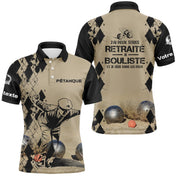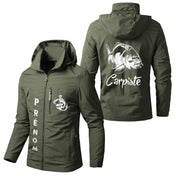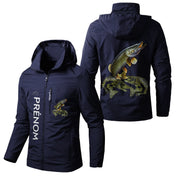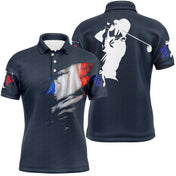
Opening in the second category means new hopes and, sometimes, a rediscovery of our river after a few months of absence from the lures. So where do we start from the edge?
A crucial point if ever there was one, the weather gives the “LA” at the opening. What were the conditions like in the previous month and weeks? So much information that makes it possible to target this or that technique, this or that type of approach and, therefore, this or that position.
What do the weather and our fishing spots say?
The warm weather often arrives around the opening date, nature is quite awake and here and there, activity: some porpoise fishing, perch hunting, rare, but it's a good sign.
The water is generally clear, the levels low. It's all there for lure fishing. The seagrass beds are not yet very present but the water lilies are arriving and the pike come out of spawning, when the zander are still there. (See box)
But sometimes we are not safe from a sudden bout of rain and cold. In this case, the conditions for casting it are more difficult. But not insurmountable. Remember, the wielded dead still exists! And there is no need to make live ones, you can find them in jars... super practical!
So learn to detect these early season trends, this atmosphere that emerges. Are you getting your bearings? So let's go.
Attacking the opening with lures also means covering ground, a lot of ground. It is therefore also the possibility of finding/falling on zander spawning areas... There, no hesitation! We need to change, move away. Leaving it alone also ensures a revival of this species. A shotgun blast, a dark flash behind your lure? Hold back, sir is defending his nest! It is capable of rising several meters to correct an 18cm and 80g jerkbait. I've seen it before, pike color or not. This type of behavior is not an attack to eat, but to prevent the intruder that is your lure. Learn to recognize this behavior and move about twenty meters away. This dearly defended offspring is of course the one that will make you take out your rods a few years later.

Everything wakes up slowly...
Your equipment is ready, you arrive at the water's edge. In the case of clear water, it is easy to spot the water lilies on the edges, which are THE spots at the start of the season! Generally, the sun warms everyone and the edges therefore offer all aquatic people better conditions after winter. There is room and board for the whites, so the predators are not far away! But from there to getting them to bite, it’s sometimes less simple. Let's not believe that spawning and the hunger that results from it will allow us everything!
Again, observe. How are water lilies located? In compact benches? Scattered ? Are there free corridors for your lures between these schools? All three of course! So three different ways to do it! And three reasons to pull out your favorite lures!
The shallow depths of this type of post can accommodate many lures. Swirling with provocative swimming, light undulating with suggestive swimming and calling from afar, swimming fish of all kinds as long as their bib does not make them dive too far. Of course, spinnerbaits And jerkbaits, complete the artillery!
The first goes everywhere and sends its numerous signals from all sides. As for the second, it provokes by aggressive swimming. But if the waters are cold, respecting pause times with this last lure is a very good solution. The message you leave him like this is: “I’m attacking you and look, I’m taunting you… before leaving! » In areas a little further from the edge with a little more depth (around 2 meters), these two lures go hand in hand! The spinnerbait will also prevent you from snags.
These are the areas that you should prioritize, because they cover the most surface area and provide the most shelter to our targets.
On the other hand, if the waters are high and colored, it is more difficult to fish these positions correctly. You lack visibility to get your lure to the right place and everything is therefore done by touch. Of course, nothing stops you from choosing a nearby body of water.
Despite everything, on the river, you can stand out from the crowd by playing up the signals. “Colorado” type blades for your spinnerbaits, Rapala Super Shad Rap 14 cm which really calls from afar, billed lures, aggressive swims over short distances and extended pause times. Here are some ingredients that make it possible to succeed.
The bait, for its part, is THE solution in these difficult conditions for the lure. It allows you to adapt by walking along the river and laying siege to all the posts you know. Large or small depths, stones or branches, perch, pike or zander... everything is possible with two rigs: the classic float and the pater noster.
A large cane for the first, a shorter one for the second. A pit of several meters, a riptide? The pater for the first, the cork for the other. The drowned tree that performed so well last year? Both edits my Captain! And then, if you run out of live bait during these high waters, there is…
Tributaries and sewer outlets
Here are posts that give the whole season, so after the opening, you shouldn't miss them! The lively ones happily gather there, especially if the main river is in flood! It is relatively easy to make swarms in these conditions, especially in the tributaries.
A red tracer leader, a 0.10-0.12 main line and a 0.08/0.10 leader on a 22 hook with a 0.5 gram float will do the job perfectly. A few fifises, these little maggots that bleaks are so fond of, will do the rest (And if you add anise syrup...). Favor areas of calm, against the current, in short all those areas which break the juice and allow aquatic life to take shelter. Don’t hesitate to put your first bait just downstream of your bait, and even add two baits on the same hook. The more people there are, the more vibrations there are that call for the predator! It’s the best way to hit a grand slam! Why, sandra, pike (catfish also) but also trout! Because the tributaries are also home to them.
In calm conditions, everything works. You just need to adapt your lure to the topography of this position. Start with small lures, 5-7cm, the big perch like to come here, especially if there are rocks lining the bottom. Nothing, no keys? Larger subjects may be in the area and keeping smaller ones away. Good sign !
So switch to 9cm lures. These big subjects appreciate them. A seductive and universal swimming wave hits the mark here. And will try other species too! Animated in "dead-handed", this triggers a lot of hits. With a wave of this type you will not only cover ground, but everything is possible: from large perch to zander, including pike or catfish! The undulante is truly a universal lure, except in my box.
Sinking articulated swimbaits give very good results here, especially in perch colors. Added to the attractive swimming style is this color giving a “competitive” touch to predators. Perch and pike are really sensitive to it.

The dead tree
Difficult to attack from the edge, this position is nonetheless inevitable! The snitch is strategic here, he avoids snags while laying siege to the post. Under the float rod and the pater noster for the furthest area.
For the lure, you must try to use the current to pass your lure under the submerged branches. Here, don't try anything other than the spinnerbait or an undulating armed with a Texan plus LS. You must therefore attack, insist, and push to the limit. This takes time and self-sacrifice. But it pays off!
(Aurélien Prevost)







